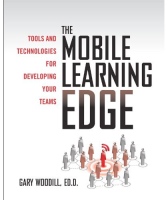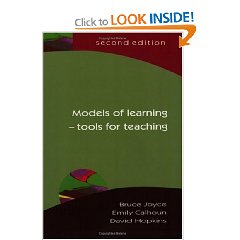Introduction
 When it arrived last Monday, my wife – in that way that only I would notice – looked at me semi-accusingly. “Another book, eh?” she seemed to say, “I thought got your books via your Kindle now?” I swear that the reason old people don’t tend to say much is because they know what the other person’s thinking.
When it arrived last Monday, my wife – in that way that only I would notice – looked at me semi-accusingly. “Another book, eh?” she seemed to say, “I thought got your books via your Kindle now?” I swear that the reason old people don’t tend to say much is because they know what the other person’s thinking.
The Mobile Learning Edge: Tools and Technologies for Developing Your Teams winged its way from Canada to the UK courtesy of my responding to a tweet from Gary calling for reviewers. As I’m currently writing a JISC Mobile and Wireless Technologies Review, it seemed rather serendipitous.
The Conclusion
In ancient times, people cut to the chase. Take St. Paul’s letters, for example. He states who he is first and only then greets the elders at the church to which he is writing. It’s always puzzled me that people only indicate who the letter is from at the very end; at least with emails you know who it’s from straight away by virtue of their email address.
So, my conclusion? The Mobile Learning Edge (hereafter MLE) is worth reading by those interested in mobile learning in a formal educational context. Whilst it (presumably due to encouragement by McGraw-Hill, the publisher) tries to be all things to all men, it nevertheless has value to those working in and with educational institutions. Woodill expertly collates and synthesizes information, presenting it in an engaging and convincing way.
Every book has its weaknesses. There is, for example, at times an uneasy glossing and assumed-similarity between the needs of those in formal learning situations and those within businesses. In addition the way in which the book is written seems to purposely align the author with initiatives in which he played no part.
But to overly-criticize MLE would be churlish. It is a readable, reasonably-comprehensive and up-to-date overview of the current state of play in the mobile learning arena. If it were available for the Kindle for £10 (as it should be) I’d recommend it without reservation. As it is, it comes recommended.
The Overview
I have to admit to chuckling a little when I read the opening pages of MLE. Only the day before I had commented about the paucity of metaphors that I come across in educational contexts. It was only after reading the whole of the introduction to MLE that I realised Woodill was setting up – quite cleverly, I thought – the rest of the book to call for a return to authentic learning. He indicates, and purports to show, that mobile learning is our natural way of learning: sitting in classrooms is something alien to us.
Figure 5.5 on page 184 of MLE features an engraving from eighteenth century Europe showing one of the most crowded, although admittedly neatest, classrooms you will ever see. Context is one of the strengths of the book: Woodill is a master at putting things in their historical place, charting the development of technologies and pointing out significances. Granted, in some cases such generalizations could be contested and rely on the tried-and-tested metaphors of hunter-gatherer communities and the industrial revolution, but they are, on the whole, sound.
Of the ten chapters that make up MLE, around seven will be of immediate interest and utility to educators not directly involved with the overall strategy of their organization. Those who do occupy such senior positions will find enlightening the chapter contributed by David Fell, interim CEO of a broadband corporation. In it, Fell discusses of the importance of ‘co-opetition’, a term that will become increasingly familiar to those in charge of schools, colleges and universities.
Easily the best part of Fell’s chapter, however, is his inclusion of and discussion around the following diagram from Ambient Insight:

Whilst usually skeptical of diagrams that look designed-for-Powerpoint this one nicely summarizes why now, in the current context, is a great time for institutions to be pursuing mobile learning initiatives.
The second contributed chapter comes from Sheryl Herle, a corporate learning consultant. This, unsurprisingly, deals with Return On Investment (ROI) and business-focused strategy. The chapter does, however, contain some gems that I’ve saved for future use, including the advice that you should be focusing on what you don’t want people to do rather than narrowly defining what you do want them to do; that IT Services/Support’s job is to deal with security threats and network stability – which is why they often oppose ‘innovation’; and that whilst it’s possible to come up with ROI figures for mobile learning initiatives they’re unlikely to be comprehensive or realistic.
Returning to the main author, Gary Woodill’s contribution to MLE, it is clear – and indeed he tells us – that he used to be a teacher. Not only that, but his doctorate (like mine) is an Ed.D. For all the discussion of ‘corporate learning’ and ’employees’, Woodill’s pedagogical background pervades MLE. Take, for example, the structure of the chapter ‘Learning by Communicating, Interacting, and Networking’:
- Quotation
- High-level overview setting the scene
- Problem (disruption of mobile)
- Some truths (we are social beings)
- Examples
- Case study
- Theory supporting examples
- Recommendations
The above, fleshed out, could form a lesson plan. This structure and method of presentation makes MLE a satisfying read.
This, as the author would admit, is a book of its time. It’s relevance in a few years’ time will be less powerful but, for now, the appendices, featuring links to relevant blogs and academic articles are a goldmine. Woodill indicates on his companion site to the book, mobilelearningedge.com that there will be a second edition of MLE and that he will use the related site to keep the content fresh.
I hope this is the case. 🙂





